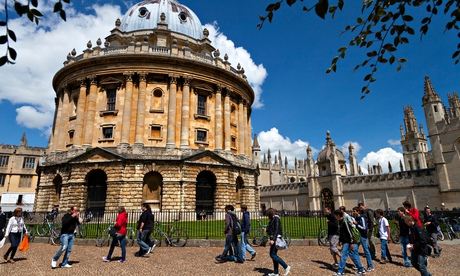上周六,香港老友女兒尚昕來參加讀書會(我們初次見面),談起留學英國的情形,學費已很不便宜了......。我這幾年只知道英國學生多次抗議tuition fee 的調漲,沒注意到漲多高了。昨天特別當面請教陳忠信兄,問他少爺幾年前在皇家藝術學院的費用,才確定從1977到2013年,約漲了10倍。(同期間台灣學費公立大學漲約10倍,私校漲約15倍。1977年英國的是台灣私校的12倍。這段期間台幣漲約33%,英鎊貶約33%。)
今天再找網頁介紹:http://www.topuniversities.com/student-info/student-finance/uk-tuition-fees-how-much-does-it-cost-study-uk
UK Tuition Fees: How Much Does it Cost to Study in the UK?
台灣高教有相對優勢 ,所以私立大學應多放眼亞洲"僑生".....
現在我捫還應該問:為什麼英國學費已很高了,海外學生人數不減呢?
How much does an Oxbridge undergraduate really cost?
Our most prestigious universities are lobbying to increase fees above £9,000, but are not transparent about their finances

The leaders of our oldest universities tell sorry tales about the losses they incur when teaching undergraduates. Andy Hamilton, the vice-chancellor of Oxford, puts the annual cost of each one at around £16,000.
After discounting the £9,000 tuition fees, he says that leaves “a funding shortfall of more than £7,000 a year per student”. Our most prestigious institutions are now lobbying to be allowed to charge more, while also looking closely at the Australian government’s attempt to abolish fee caps.
The full picture is complex. The Higher Education Funding Council for England (Hefce) still subsidises disciplines that are more expensive to teach. It also funds widening participation and retention work, and even provides Oxford and Cambridge with their own special funding because they provide a distinctive education. So whatever the shortfall, it is less than £7,000.
Moreover, our leading universities choose to spend a relatively high proportion of their tuition fee income on student bursaries – despite evidence to show there are more cost-effective ways of boosting applications from under-represented groups. Until institutions can prove maximum bang-for-buck on current spending, their case for more cash will lack credibility.
Frustratingly, no one ever explains how figures like £16,000 are calculated. I have been fruitlessly asking Oxford to explain its component elements for years. I have put the same question to Cambridge, on its slightly lower figure of £14,800, with the same result. Those who use such figures resemble schoolchildren answering their maths homework with a single number and no underlying workings.
We do not know if the figure is made up exclusively of things that are – and should be – part of studying at a world-class university, such as excellent teaching, a world-class library and good sports facilities. Or whether it includes costs that cannot easily be regarded as an integral part of undergraduate teaching, including well-stocked wine cellars and other college perks.
One reason why higher education institutions are reluctant to produce detailed numbers on their costs is that it would expose internal cross-subsidies. Disciplines that can be taught for less than £9,000 – such as arts, humanities and business – may be subsidising those that are not self-financing, and enabling surpluses for future building projects.
There are two competing views about such cross-subsidies among those working and studying at universities: they should not happen, or they should be concealed. Neither is right. Students typically want to study in broad-based institutions, and some cross-subsidies are reasonable in any multibillion pound charity such as a modern university. Today’s students benefit from the investments of yesterday and are in turn securing their universities for tomorrow.
If the £16,000 figure were ever to be proved right, it would need to be taken seriously. It would put a question mark over a core business of our most famous universities, which would be an issue for the whole UK education sector. Oxbridge could, in time, refuse to accept so many undergraduates, or even become postgraduate-only. That would be a tremendous loss.
One way to tackle any shortfall in funding would be to raise the tuition fee cap above £9,000, as some research-intensive universities want. But people talk as if that is an easy thing to do. In reality, it is inconceivable that the Commons that meets after the 2015 election will vote for a much higher fee cap on the thin evidence base we have. At the moment, there is more chance of a lower cap than a higher one, not least because Labour is flirting with a cut to £6,000.
MPs of all parties have spent enormous political capital on higher education funding in recent years and are disinclined to spend much more.Tony Blair’s £3,000 fees scraped through with a Commons majority of just five. The deputy prime minister, Nick Clegg, has yet to recover from undertaking the clearest breach of faith of any contemporary politician when he shifted from promising to abolish fees during an election to tripling them soon afterwards.
The next 12 months pose a threat to universities. Whatever the outcome of the 2015 general election, there are likely to be substantial cuts in the spending review that follows.
Staving off those reductions will need more than a gentlemanly phone call from a vice-chancellor or two to the cabinet secretary. It will need hard and detailed evidence on what it really costs to deliver world-class higher education. Universities’ internal finances should be exposed to sunlight, so that policymakers, students and taxpayers can properly understand them.
Nick Hillman is director of the Higher Education Policy Institute
沒有留言:
張貼留言